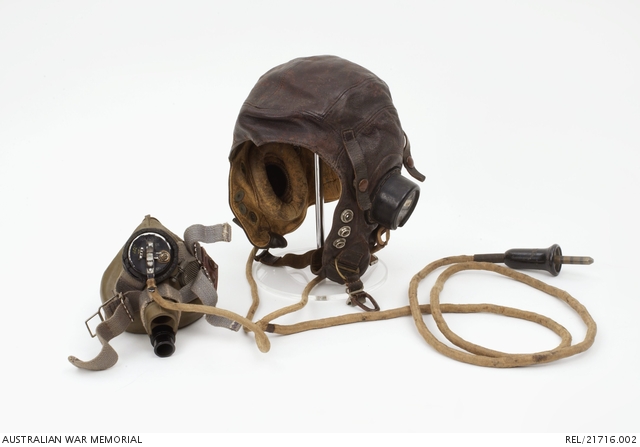| Places | |
|---|---|
| Accession Number | REL/21716.002 |
| Collection type | Heraldry |
| Object type | Personal Equipment |
| Physical description | Chamois, Elastic, Metal, Plastic, Rubber |
| Maker |
Air Ministry |
| Place made | United Kingdom |
| Date made | c 1943-1945 |
| Conflict |
Second World War, 1939-1945 |
British Type G oxygen mask with Type 26 microphone : Flight Lieutenant Stephen Joseph Mondel, RAAF, 57 Squadron RAF

Type 'G' green rubber oxygen mask with built-in Type 26 magnetic microphone. The mask is lined with brown chamois leather, and has blue/grey elastic straps for attachment to a flying helmet. The left hand cheek of the mask has a mesh covered valve to allow the passage of ambient air. Raised markings on the mask read 'A M MEDIUM' (size) and 'DETACH TUBE HERE' with an arrow indicating the location point. The microphone has a black painted aluminium circular front with a rotating On/Off switch, and is impressed '10A/12570'. A black rubber seal holding the microphone in place is marked '10A/12574'. An insulated lead emerging from the base of the microphone ends in a dome shaped plug for attachment to aircraft radio equipment. Below the microphone, on the base of the mask, are inlet and exhaust valves for the oxygen supply, but the black rubber oxygen hose which should attach to the inlet valve is not fitted. As the electrical cord from the microphone connects directly to the radio receivers on the flying helmet, (REL/21716.001) the two can only be separated by disconnecting the wires from one or the other.
The Type 'G' oxygen mask entered RAF service in 1943. Its main advantage over earlier masks was in the channeling of cool fresh oxygen into the upper part, while carrying warm exhaled air out at the bottom. Together with the new chamois lined rubber construction, this largely alleviated the condensation problems experienced with earlier masks. The Type 'G' was extensively used by RAF and RAAF aircrew for the remainder of the war, and remained in service well afterwards.
This helmet and mask was worn from 1943 by 15032 Flight Lieutenant Stephen Joseph Mondel, RAAF, who served in 57 Squadron, RAF (Lancasters). He enlisted the RAAF in 1940 and trained in Australia as a Fitter. He joined 456 Squadron RAAF in North Wales in June 1941, as a Sergeant Air Gunner. Mondel subsequently qualified as a Flight Engineer and was posted to 57 Squadron RAF based at Scampton near Lincoln. He was awarded the Distinguished Flying Medal on 14 September 1943 for his reliability, vigilance and leadership.
Mondel was posted to India in August 1943 to work with 1577 (Special Duties) Flight using his engineering expertise to assess radar and technical problems associated with towing gliders, such the Horsa and Hamilcar, in the tropics. In July 1944 he returned to Australia and was posted to 7 OTU at Tocumwal. He was discharged in September 1945.